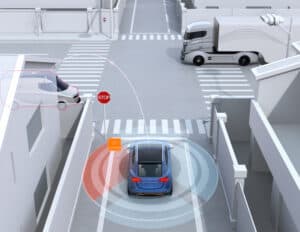
5G and edge technologies are expected to provide the bandwidth, low latency, and reliability that address the needs of connected cars.
Hyper-connected cars are finally becoming a reality thanks to the rise of 5G technology and a group of interrelated trends that are transforming the automotive industry. “ACES” – autonomous driving, connectivity, electrification, and shared mobility – are now feasible for actual implementation, thanks to the substantial increase in bandwidth, low latency, reliability, and distributed capabilities that 5G provides.
That’s the word from a recent report out of McKinsey, which predicts edge computing, onboard cloud processing, and 5G is reshaping the driving experience as we know it by enabling advanced capabilities in connected cars.
The McKinsey team estimates the total value created by connected-car use cases to increase from about $65 billion in 2020 to $450 billion to $500 billion by 2030. Over that same period, the percent of value enabled by 5G and edge will increase from about five to 30%. This means new evolutions of the hardware and software now embedded in automobiles or supporting the production value chain.
5G and edge technologies are expected to provide the bandwidth, low latency, reliability, and distributed capabilities that better address the needs of connected-car use cases. At the same time, the report adds. Non-safety-critical automotive workloads, such as infotainment and smart traffic management, “could start to shift to the edge from onboard or in the cloud.” Eventually, the report’s authors add, “5G connectivity could reduce latency to the point that certain safety-critical functions could begin to be augmented by the edge infrastructure, rather than relying solely on onboard systems.”
See also: For Connected Vehicles, It Pays to See the Future
Examples of 5G-connected, software-driven automotive features include autonomous emergency braking systems, forward collision warning, onboard cooling management, and over-the-air updates.
McKinsey predicts 5G-enhanced solutions will deliver three levels of connectivity within smart automobiles:
- Enhanced mobile broadband (EMBB): “5G may provide faster, more uniform user experiences with speeds reaching ten gigabits per second, five to ten times faster than 4G technology. This may enhance high-bandwidth use cases such as in-car infotainment, vehicle teleoperation, and real-time human-machine-interface rendering.”
- Massive Internet of Things (IoT): “By enabling up to a million connections per square kilometer, 5G networks could efficiently support a large number of concurrent connections from cars on the road, connected infrastructure endpoints, and end-user devices. This may eliminate the possibility that cars and other devices get disconnected from the mobile network inadvertently because of a large number of connections.”
- Ultra-low-latency communications (URLLC): “5G latency can theoretically go down to one millisecond—five to 15 times better than 4G. This means 5G can combine high speed with high reliability, eliminating the need for trade-offs between the two. This is important for object tracking in autonomous vehicles, the protection and control of smart-grid critical infrastructure, and remote-control and process automation for applications including aviation and robotics.”
With the rise of 5G and edge will also come a major transition within the industry itself. All companies along the automotive value chain, semiconductor players, tier-1 suppliers, OEMs, communication system suppliers, and hyperscalers “could increase value capture in the evolving automotive landscape,” the authors predict. Traditional players may move into adjacent markets, and there will also be an influx “by new entrants from industries not traditionally in the automotive value chain, such as communication system providers, hyperscalers, and software developers,” they add. “Players such as Intel, Nvidia, and the Taiwan Semiconductor Manufacturing Company are adding automotive-software capabilities, leading to greater synergies and vertical-integration benefits.”
Related: They’re No Longer Cars, They’re Computers on Wheels







